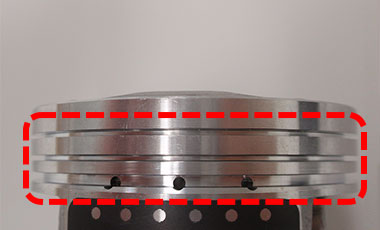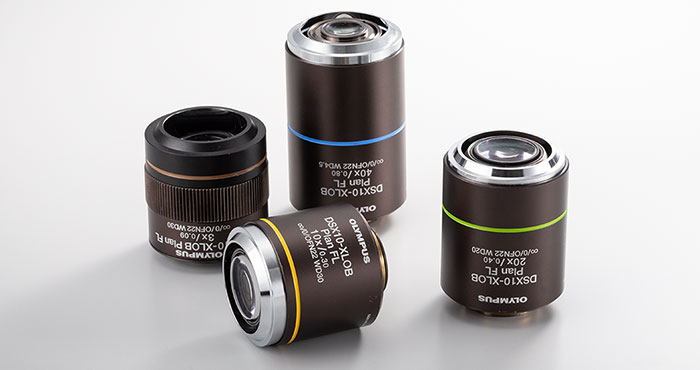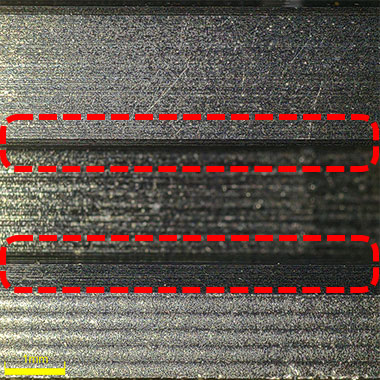Burrs on Pistons in Car Engines
In the combustion chamber of a cylinder block, a piston rapidly slides up and down several thousand times each minute, reaching temperatures as high as several hundred degrees Celsius to generate enough power to drive the car.

Piston.
To function correctly, the piston must have heat resistance, abrasion resistance, and low thermal expansion.
In addition, the piston should be machined with no burrs so that it can slide quickly and seamlessly. If there are burrs, especially in the grooves of the piston, it can result in engine problems.
Since the grooves accommodate piston rings, which slide in direct contact with the cylinder liner, a burr can cause the piston ring to fit improperly and result in problems with combustion in the engine.

The red dotted rectangle shows piston ring grooves without any burrs.

Piston cross section.
Piston Ring Grooves with No Burrs
A groove with no burrs helps ensure that the piston ring fits correctly. The piston can slide seamlessly across the cylinder liner.
Piston Ring Grooves with a Burr
If a groove has burrs, the piston ring protrudes from the groove and may cause issues, such as:
- A gap is created between the cylinder liner and the piston ring, causing gas from the fuel combustion to leak. The force that moves the piston up and down will then decrease, leading to less engine power.
- The piston ring applies more pressure on the cylinder liner than necessary, preventing the piston from smoothly sliding up and down.
Inspecting pistons for burrs using a microscope can help prevent these issues. To do so, inspectors must perform a low-magnification observation to identify burrs, then acquire high-magnification images to investigate any detected burrs.
Digital microscopes are frequently utilized for these inspections as there is no need to damage or cut the pistons for the observations.
However, it can be difficult to inspect pistons using a microscope because of their cylindrical shape and the several-millimeter depth of the piston ring grooves. As a result, these inspections require skilled technicians.
Benefits of Inspecting Burrs on Pistons Using the DSX1000 Digital Microscope
The DSX1000 digital microscope provides several benefits to overcome these difficulties and produce a more efficient, intuitive workflow that inspectors of all skill levels can perform.
1. Observe Small Burrs with Clear Images at Low Magnification
The DSX1000 digital microscope is equipped with dedicated objective lenses that deliver sharp images at low magnifications. Users can observe very small burrs with these lenses.

XLOB long working distance DSX objectives.

42x image focused on the top of a piston ring groove. You can clearly see the condition of the groove edges.

42x image focused on the bottom of a piston ring groove. You can clearly see that there are no burrs.

42x image focused on both the top and bottom of a groove using the omnifocal function. You can clearly see the edge of the cooling channel hole.
2. See the Piston Ring Groove from Different Angles with a Tilting Frame
Due to the DSX1000 microscope’s optical design, the field of view remains in place even when the head is tilted. The flexible tilting frame enables the user to conveniently inspect a ring groove all around the outer circumference of the piston.

Tilting head of the DSX1000 microscope.

Easily observe cylindrical pistons by accurately aiming at the part of interest from an angle.

42x image acquired with the DSX1000 microscope head tilted at a 70º angle. You can clearly see the edges of the piston ring groove.
3. Instantly Switch to a Higher Magnification Objective to Analyze Burrs
Once a burr has been identified, inspectors must observe and investigate its condition in greater detail.
Most conventional digital microscopes only provide one lens, which makes this step challenging. While zooming in with the lens increases the magnification of an image, it cannot enhance the image quality.
To capture high-magnification, high-quality images, the mounted objective lens must be replaced with a high-power, high-resolution objective lens.
The DSX1000 digital microscope provides a head that can mount up to two objectives at the same time, enabling the user to adjust the magnification just by sliding the objective lenses.

Users can also mount a new objective lens in one step by inserting the lens attachment into the head. The lens attachment includes a built-in sensor, enabling the microscope to determine which lens is being used, along with the magnification and the field of view.


High-magnification (500x) image of the edge of a piston ring groove. You can clearly see that the edge is straight.

High-magnification (500x) image of the bottom of a piston ring groove. You can closely observe the machined state.

This information has been sourced, reviewed and adapted from materials provided by Evident Corporation - Industrial Microscopy.
For more information on this source, please visit Evident Corporation - Industrial Microscopy.